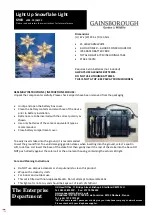
26
the number of loops and note the geometry of the pipette (viewed with microscope). As
the VELOCITY increases, the number of loops decreases.
4.
Repeat step (3) only this time decrease the VELOCITY. As the VELOCITY decreases, the
number of loops increases.
5.
By adjusting the VELOCITY as described, establish the number of loops required to
approximately form a pipette with the characteristics you desire. Set the VELOCITY
value in your program to the number that falls midway between the values required to
loop one more and one less times than the desired number. This is called the “mid-point
velocity”. For example, while experimenting with VELOCITY values, you find that when
the glass separates after 3 loops the resulting pipette looks pretty reasonable. Let Y be
equal to the VELOCITY value that results with the glass separating after four loops. Let
Z be equal to the VELOCITY value that results with the glass separating after two loops.
Set your program VELOCITY, to a value midway between Y and Z. This value will be a
very stable VELOCITY value and will provide you with the most reproducible results.
6.
The one line program just established may be sufficient for your application. However,
changes made in a one-line program are amplified throughout the cycle, potentially
producing gross changes in the pipette. If you need to make fine adjustments to the
pipette geometry, then you should use a multi-line program. The multi-line program is
based on the one line program just established. It is developed as follows:
7.
Write your one-line, looping program out into an equivalent multi-line program with the
number of lines equal to the number of loops. For example, a one line, 4 loop program
with the following values:
HEAT
PULL
VELOCITY
DELAY
Loops 4 times
525
0
23
1
The program could be rewritten into an equivalent 4 line program:
HEAT
PULL
VELOCITY
DELAY
Line 1
525
0
23
1
Line 2
525
0
23
1
Line 3
525
0
23
1
Line 4
525
0
23
1
8.
Now, you can make adjustments to the last or next to last line to fine-tune the program
and the resulting pipette.
9.
Recommended changes to fine tune the multi-line program:
For larger diameter tips:
Decrease HEAT in last line.
For smaller diameter tips:
Increase or decrease VELOCITY in next to last line by
2 to 3 units, or increase/decrease VELOCITY in last
line by 2 to 3 units, or add a small amount of PULL
(10 to 20) to last line.
P-97 FLAMING/BROWN MICROPIPETTE PULLER OPERATION MANUAL – REV. 2.43 - DOM (20161118)
Summary of Contents for P-97
Page 3: ......
Page 4: ......
Page 66: ...56 NOTES P 97 FLAMING BROWN MICROPIPETTE PULLER OPERATION MANUAL REV 2 43 DOM 20161118...
















































